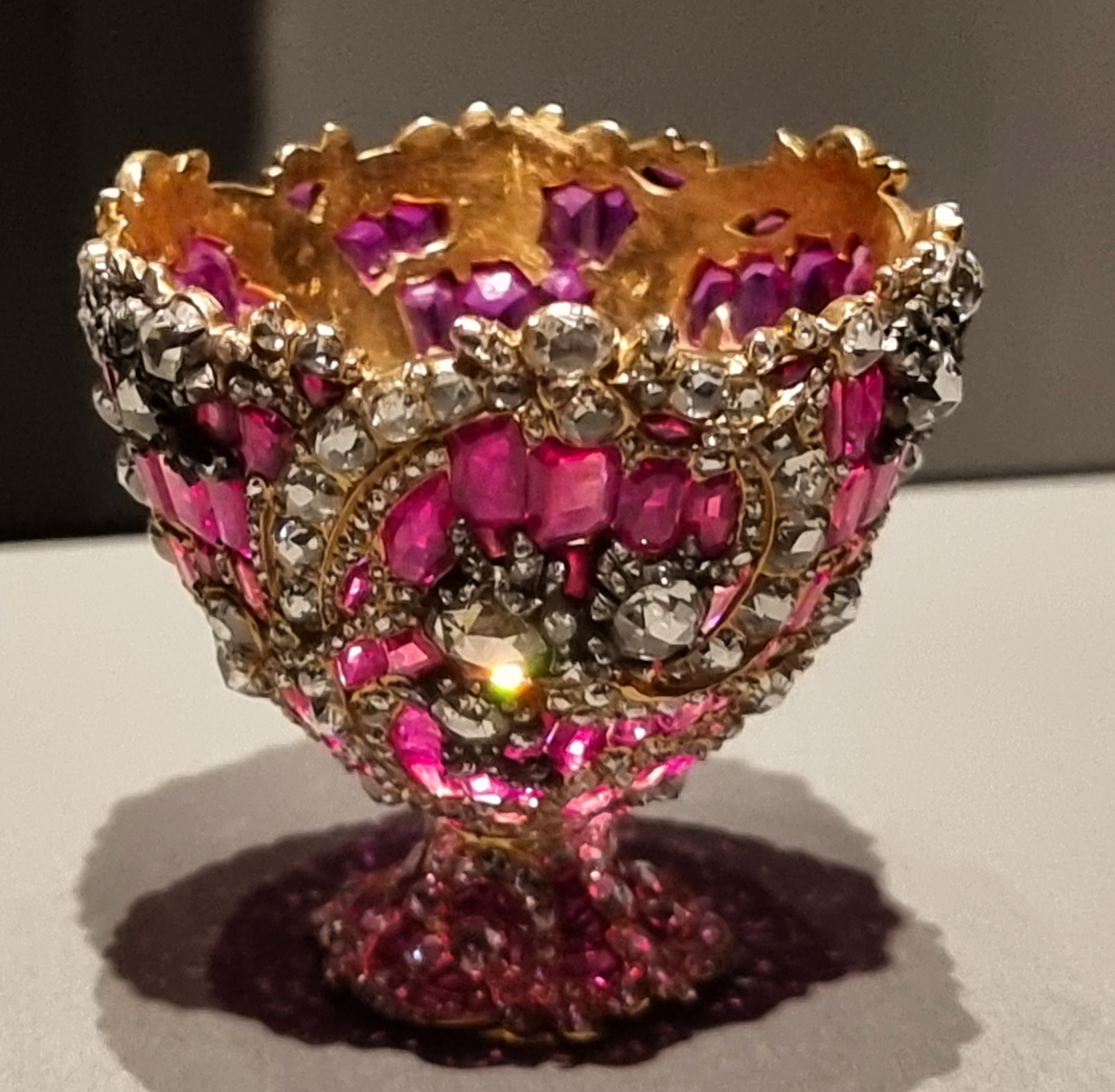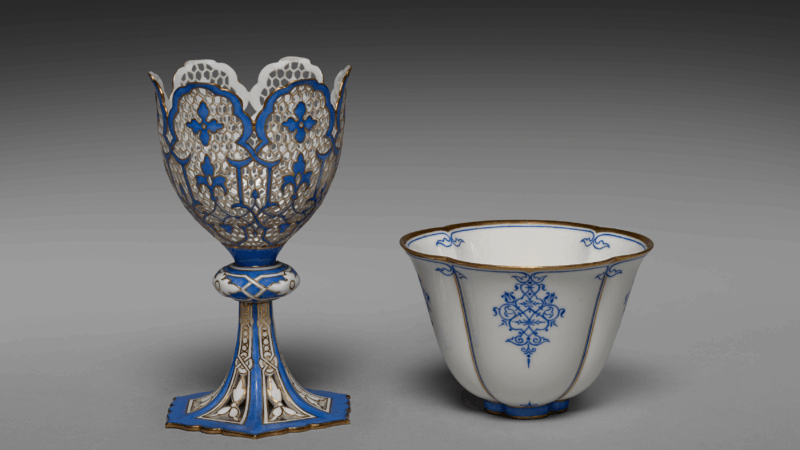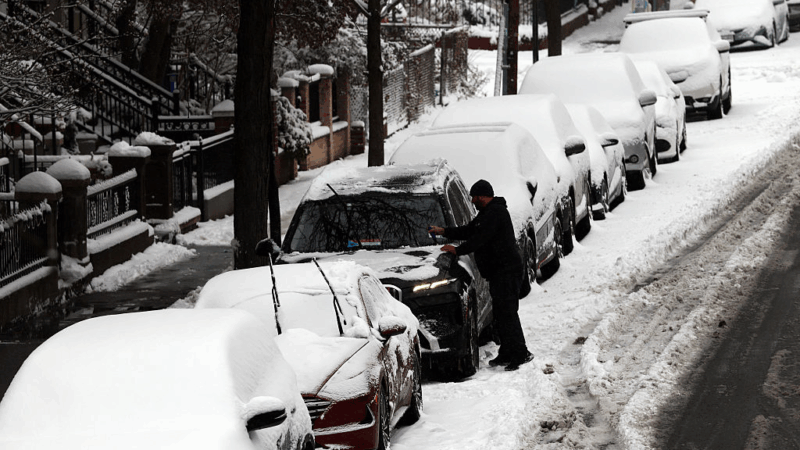What to know about zarfs, the fanciest way to drink coffee
Does your favorite coffee mug have a funny pun or cool art? Or maybe an intricate ceramic design?
How about stepping things up and having some jewelry with your java?
Enter the zarf, a Turkish word meaning “envelope.” It refers to decorative devices used especially during the Ottoman era to hold hot cups of coffee.
And more recently it could be a term for those ubiquitous cardboard sleeves that keep your hands from overheating. In this edition of Word of the Week, we delve into coffee’s past to understand the role of the zarf.
Coffee is more than just coffee in Turkey

Coffee is a big deal in Turkey and has been for hundreds of years. The Turkish way of serving coffee has been recognized by UNESCO, the United Nations cultural agency, for its cultural importance.
Coffee made its way to what is now Turkey during the Ottoman Empire, at least as far back as the 16th century.
“For the Ottomans, coffee serving was a ritual, and it was also an art form. So it wasn’t just some kind of a coffee drinking ceremony. Everything from the serving, brewing — everything was part of that ritual,” says Gizem Şalcıgil White, the founder of Turkish Coffee Lady coffee shops and foundation and an evangelist for Turkish coffee.
Preparing coffee the Turkish way involves grinding the beans very finely, and slowly cooking the water and coffee in a pot to create a thick layer of foam. It’s served in small cups.
That’s where the zarf comes in. “The zarf is actually a handle for these tiny little coffee cups,” White says. “It’s supposed to be functional, but at the same time is the symbol of Ottoman luxury lifestyle. It’s more like, you know, a statement of rank or elegance, sophistication, because Turkish coffee is a cultural treasure for the Ottomans.”
Zarfs have come in various forms, from stripped down metal to intricate floral designs, colorful enamel and carefully inlaid jewels.
Cenk Girginol, a Turkish coffee consultant and author of the book Coffee: From the Soil to the Cup, says zarfs began to be used at the end of the 17th century and beginning of the 18th century.

Zarfs were often made of metal, while the coffee cup would be made of ceramic or glass, according to the Khalili Collections art collection.
Zarfs could feature silver and gold in their construction, White says. She says Ottomans would break out the fancy zarfs for visiting ambassadors. But ordinary people could also use zarfs in their homes, Girginol says in an email.
By the 19th century, goldsmiths in Geneva were making zarfs to export, according to the Khalili Collections. Recent auctions and museum collections show zarfs that were made in France, Syria, Iran and Switzerland. A zarf in the Louvre’s collection, covered in emeralds and diamonds, was owned by Abdul Hamid II, the sultan of the Ottoman Empire in the late 1800s and early 1900s.
In English, the word “zarf” appears in accounts of travelers to the Ottoman Empire in the mid-19th century, says Douglas Harper, editor of Etymonline.com.
“It’s an Eastern exotic product that the Europeans don’t have, but they’re writing about,” he says.
(Even though zarfs are often associated with Turkey, the word is of Arabic origin, according to George Berg, a professorial lecturer in Arabic studies at American University, who says “it primarily means container or vessel.” Harper notes that many Arabic-speaking areas were at certain points under Ottoman rule.)
Today, you’re unlikely to be served coffee in a fancy zarf even in historic coffeehouses in Istanbul, White says.

“The zarfs are considered very prestigious presentation, like you cannot just serve it to your customers as an item on your menu. There has to be a ceremony. There has to be a special occasion.”
However, she does have zarfs for serving coffee in her shops in the U.S.
A zarf that’s not a zarf

Zarf has never really caught on in English, except for some people “who like to show off their vocabulary,” according to Harper, or the occasional crossword puzzle answer.
Still, some definitions on the internet include a disposable coffee cup sleeve under the “zarf” definition.
Jay Sorensen created the Java Jacket in Portland, Ore., in the early 1990s, a version of the now-ubiquitous cardboard coffee cup sleeve. He was the first to widely market this type of product in the U.S.
The idea came after he spilled coffee on himself. Polystyrene cups were banned in Portland, he says, and coffee was being served in paper cups.
“I went through one of the first gourmet drive-throughs in Portland called Coffee People, and they used to hand it to you with napkins. And I was driving a ’64 Ford pickup, a three speed on the column, and I dropped the cup of coffee in my lap and burnt myself. It wasn’t severe, but that got me thinking,” he says.
He originally toyed with the idea of a double-walled cup before settling on the Java Jacket.
The company grew, reaching close to a billion units sold in 2016, he says.
These days they are facing more challenges. Their patent expired a decade ago and companies from Asia and Eastern Europe are now “flooding the market.”
And iced coffee is getting more popular.
“It used to be, cold drinks were basically a summertime phenomena,” Sorensen says. “But now if you look at the statistics, cold has taken up a pretty big portion of all coffee drinks year-round now. So that hurts.”
But back to zarfs. Sorensen says someone mentioned the word to him maybe 30 years ago.
“I didn’t pay much attention to it, but then it’s popped up many times since then. … I always just thought of it as a word for a coffee holder that, you know, somebody used in Islam hundreds of years ago.”
White is on the same page as far as zarfs go. Asked if she would ever call a cardboard sleeve a zarf, she says, “I would not.”
“It has a lot of meaning, it’s not just, you know, a functional holder,” she says. “It’s part of the ritual” of Turkish coffee.
Harper says zarf is “an old word, but a very specialized old word. And the transfer of it to a modern sort of commercial product, people who are familiar with the old thing would sort of roll their eyes at that. And people who aren’t would say, ‘That’s cool, we need a word for that.'”
Jeffrey R. Holland, next in line to lead Church of Jesus Christ of Latter-day Saints, dies at 85
Jeffrey R. Holland led the Quorum of the Twelve Apostles, a key governing body. He was next in line to become the church's president.
Winter storm brings heavy snow and ice to busy holiday travel weekend
A powerful winter storm is impacting parts of the U.S. with major snowfall, ice, and below zero wind chills. The conditions are disrupting holiday travel and could last through next week.
Disability rights advocate Bob Kafka dead at 79
Bob Kafka was an organizer with ADAPT (American Disabled for Attendant Programs Today), a group which advocates for policy change to support people with disabilities.
‘It’s behind you!’ How Britain goes wild for pantomimes during the holidays
Pantomimes are plays based on a well-known story — often a fairy tale — which are given a bawdy twist. The audience is expected to join in throughout, shouting as loudly as they can.
Kennedy Center vows to sue musician who canceled performance over Trump name change
The Kennedy Center is planning legal action after jazz musician Chuck Redd canceled an annual holiday concert. Redd pulled out after President Trump's name appeared on the building.
Our top global photo stories from 2025: Fearless women, solo polar bear, healing soups
These stunning photos include a polar bear in a Chinese zoo, a teen in Zambia facing an uncertain future, Mongolian kids watching TV in a tent, a chef prepping a bowl of good-for-you soup.







